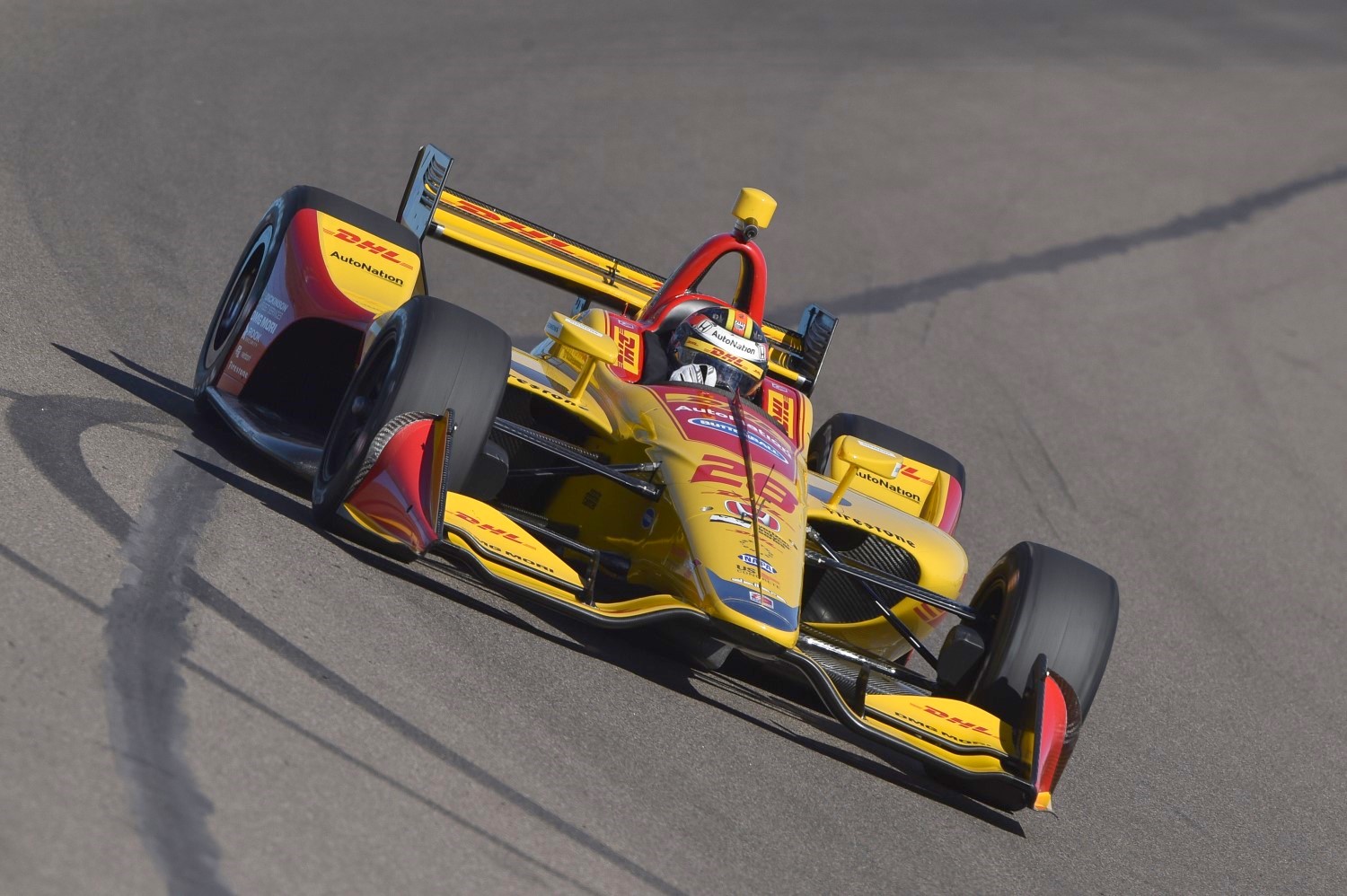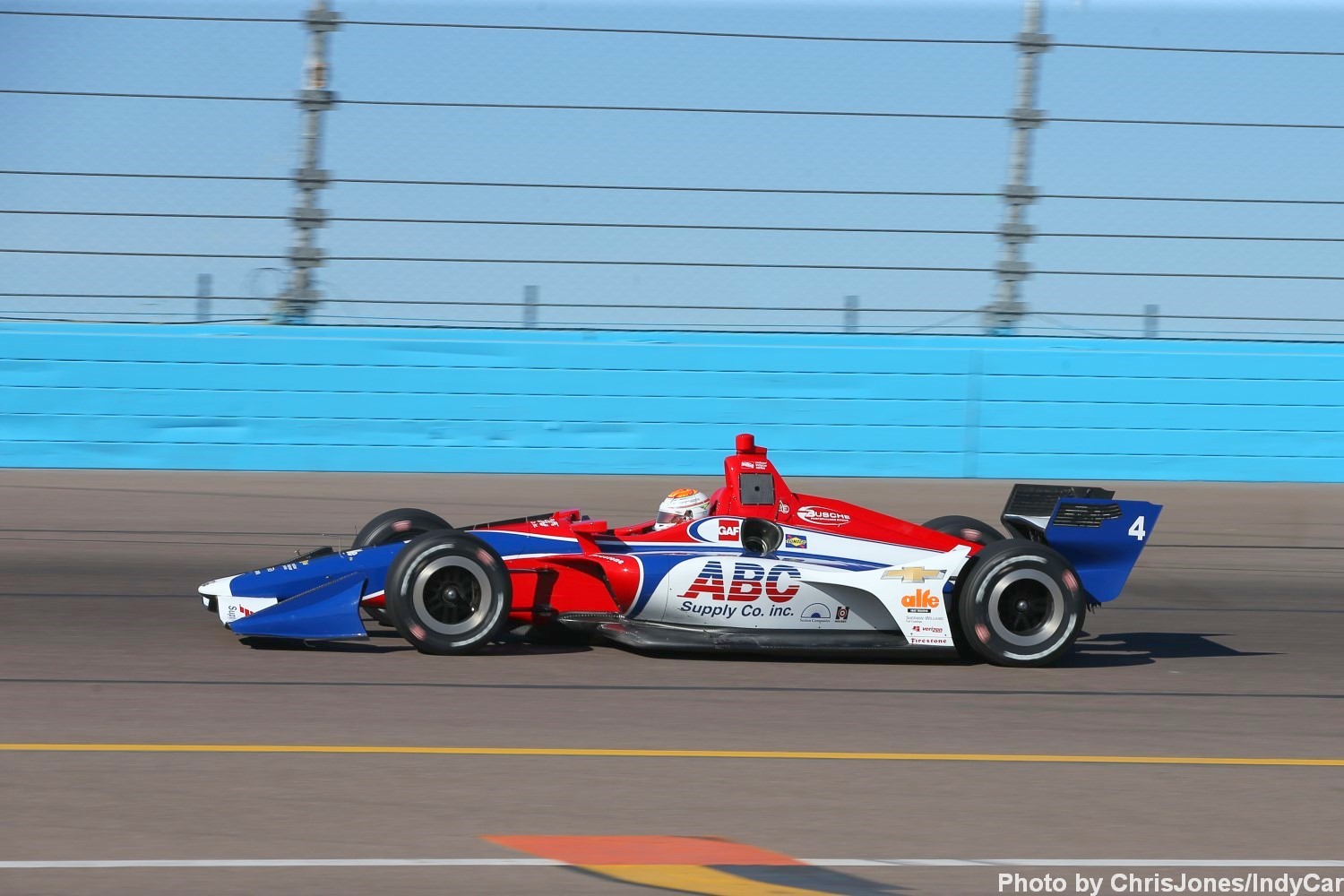Friday Evening IndyCar Observations from ISM (2nd Update)
 |
| Ryan Hunter-Reay says the cars become a handful after 20 laps or so and that should create opportunities to pass |
UPDATE Come April 7th we might actually see some passing during the Phoenix race, and we are also likely to see a slew of accidents. With the new setups, tires are going off after 20 or so laps of a 60 or 70 lap stint. The cars are becoming a handful and when that happens the drivers who have the best setup on long runs might be able to make passes, and those who don't , or who run out of talent, are likely to end up in the wall.
"From my perspective, it's very difficult out there," Hunter-Reay told Racer. "After 25 or 30 laps, you feel like you're hanging on for dear life. On the one hand, that's great; you feel like you're fully in charge of the car instead of being flat [out] the whole time because of the downforce. But then you realize a stint is going to be 60 to 70 laps, and if your tires are done barely halfway through every stint…
"It's going to be a handful, that's for sure. Even if you're taking great care of your tires, I don't think you're going to get close to the end of a stint running the type of speeds you did at the beginning. That drop off is going to be pretty severe."
"Behind the wheel, what it really feels like to me is the downforce level, in conjunction with the current Firestone tire compound, doesn't match," he added. "We'd gone down the road with a tire that had to be developed to deal with the massive aero loads, and now that we don't have all that downforce, it feels more like a speedway tire – something that's harder so it can deal with the higher speeds and scrub.
"But when the speed decreases and the aero load decreases to what we have at Phoenix, it feels like the tire is up on top of the track. I think there's going to be passing, but it's going to be like the test where an ill-handling car bottlenecks everyone up, and we're going to be tripping over each other to get by. It's like wearing your sneakers on ice. It's a product of the development path we've gone down, which is no fault of Firestone."
 |
| Handford Device on a Penske car at Michigan in 2001. More advertising space = $$$ |
02/10/18 Talking to more people in the paddock, it's clear IndyCar has failed. The new aerodynamics of the car might mean even less passing than with the old car, and with the old car it was near zero here in Phoenix. The new car's handling does not stay balanced (some call it diabolical), so passing a car will be very difficult.
The AR1.com solution? Add a Handford Device (devised by aerodynamicist Mark Handford) on the back wing and used by CART in the early 2000s. This will open up a nice hole in the air and the cars will be able to slingshot. Would be very effective on all ovals except maybe Iowa, which is very short. It will slow the lap times, but fast lap times usually equals a horrible show for the fans.
Cost of plate on back wing (Handford Device) is about a few hundred dollars. Passing be possible, fans will love it like they always loved the CART Handford Device races, and team owners will have more space for advertising revenue. Problem solved. Of course they did not ask us for our advice so they will have a parade instead of a race.
 |
| Leist spun but kept it off the wall |
02/09/18 The evening test session here in Phoenix started at 6 pm local time and ended at 9 pm. It was just before sunset when the session started and all of the drivers have been on track this evening. There have been numerous yellow flags, one for debris on the track and the others for track inspection. One incident happened at 8:28 pm when the 19 year old Brazilian rookie driving for Foyt Racing this season, Matheus Leist, spun in turn 2 but did not make contact with the wall.
In this afternoon press conference, the Team Penske drivers talked about the new car and what they are experiencing. It is much different from the old car and I have heard most people feel the drivers that drove in the CART days might adapt their driving style better than the younger or newer drivers to the series.
Simon Pagenaud, the 2016 series Champion, was asked how he felt the new car was handling on the ovals and the road courses. Pagenaud replied, "Yeah, in general, lots of differences. It's quite difficult to put a finger on it yet, on exactly what the car does in every situation because it seems to be doing different things at different tracks, which I think the problem is we've been used to having so much downforce, it's been overshadowing everything."
Josef Newgarden, the 2017 series Champion, added his feelings. "I think street courses will be the biggest change. Short ovals I would say will probably be right behind that. Those are two biggest places."
 |
| Will Power |
"Phoenix is a place where a lot of things are going to happen. You're running qualifying downforce level at the moment looking at last year's car. With that, there's a lot going to be different. You have to look out for the cars differently, you have to drive the car different."
"I think we don't know yet if that's going to be better for racing. We were discussing that. I think this is a great evaluation not only for the teams and drivers to work on their new setups for the car, to figure that out, but I think for IndyCar, they'll be observing what they think about the current downforce spec and they will get a good idea of that tonight when everyone gets together."
Will Power, the 2015 series Champion, added his thoughts on the driving style from the CART/Champ Car days. " Yeah, I remember racing the Champ Car at Milwaukee. Just needed more power. I think that was a big thing, how hard it was to get throttle on the short ovals. That's why I thought, yeah, I think we should use the road course power here. Yeah, everywhere really, but particularly here. It's the most difficult short oval to have a big race."
It is interesting to see the engine mix on the timing chart where the top two spots are Honda and the next three are Chevrolet. Graham Rahal, driving for Rahal, Letterman, Lanigan Racing, claimed the top spot and his teammate, Takuma Sato, was second fastest. Simon Pagenaud, Josef Newgarden and Tony Kanaan rounded out the top five tonight.
And there were some passes tonight in turn 2. They looked like pretty smooth passes from my viewpoint in pit lane.
Be back here tomorrow afternoon to see how testing progresses and what the teams learned after tonight's session.
Lucille Dust reporting live from ISM
